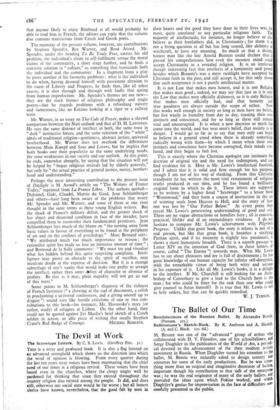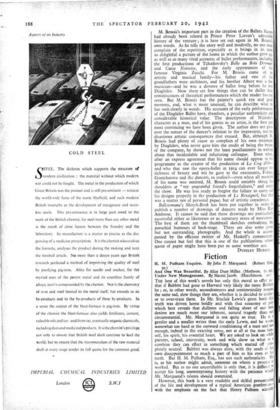The Ballet of Our Time
Reminiscences of the Russian Ballet. By Alexandre Benois. (Putnam. ass.)
Balletomane's Sketch-Book. By K. Ambrose and A. Haskell (A. and C. Black. las. 6d.)
M. BENOIS was one of the " advanced" group of artists who collaborated with D. V. Filosofov, one of his schoolfellows, and Serge Diaghilev in the publication of the World of Art, a periodi' cal devoted to the advancement of the then modern artistic movement in Russia. When Diaghilev turned his attention to the ballet, M. Benois was naturally asked to design scenery and costumes for some of the early productions. But he was soma thing more than an original and imaginative decorator of ball important though his contribution to that side of the enterprise was; was the real originator of many of the early ballets, and, provided the ideas upon which Fokine worked, and which Diaghilev's genius for improvisation in the face of difficulties sue cessfully presented to the public, M. Benois's important part in the creation of the Ballets Russel had already been related in Prince Peter Lieven's admirable history of the venture ; it is here set out again in M. Benois's own words. As he tells the story well and modestly, no one need complain of the repetition, especially as it brings in its train so delightful a picture of the home in which the author grew up, as well as so many vivid accounts of ballet performances, including the first productions of Tchaikovsky's Belle au Bois Dorm= and Casse Noisette, and the early appearances of the famous Virginia Zucchi. For M. Benois came of an artistic and musical family—his father and one of his grandfathers were architects, and his brother Albert was a fine musician—and he was a devotee of ballet long before he met Diaghilev. Now there are few things that can be duller than reminiscences of theatrical performances which the reader has not seen. But M. Benois has the painter's quick eye and good memory, and, what is more unusual, he can describe what he has seen clearly in words. His accounts of the early performances of the Diaghilev Ballet have, therefore, a peculiar authenticity and considerable historical value. The description of Nijinsk's character as a man, and of his genius as an artist, is the best ani most convincing we have been given. The author does not glc.i over the nature of the dancer's relation to the impresario, nor th: disastrous artistic consequences that ensued. But, although M. Benois had plenty of cause to complain of his own treatment by Diaghilev, who never gave him the credit of being the brair. of the company, he shows not the least pusillanimity in writing about that incalculable and infuriating colleague. Even when, after an express agreement that his name should appear in the programme as the creator of the production of Le Coq d'Or- and who that saw the opera-ballet in 1914 can ever forget the richness of beauty and wit he gave to the executants, Fokine, Gontcharova and the dancers, to realise?—even when all mention of his name was omitted, M. Benois could amiably shrug hit shoulders at " my ungrateful friend's forgetfulness," and enjoy the show. He was less ready to forgive the failure to carry out his designs properly in thz production of Le Rossignol, but that was a matter not of personal pique, but of artistic conscience.
Balletomane's Sketch-Book has been put together in order to publish a number of drawings of dancers made by Miss Kay Ambrose. It cannot be said that these drawings are particularly successful either as likenesses or as summary notes of movement The best of them are the thumbnail sketches embodying the parochial humours of back-stage. There are also some good. but not outstanding, photographs. And the whole is accom- panied by the efficient twitter of Mr. Haskell's commentary. One cannot but feel that this is one of the publications whose quota of paper might have been put to some worthier use.
DYNELEY HUSSEY.



























 Previous page
Previous page